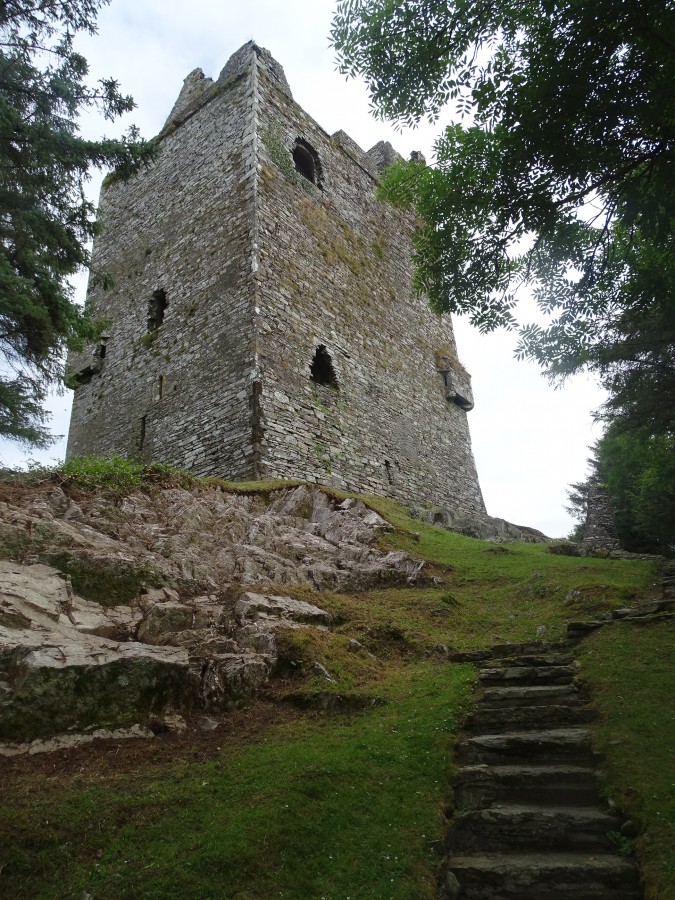Kieran’s Our City, Our Town Article,
Cork Independent, 12 December 2019
Gems From West Cork
My new book, 50 Gems of West Cork (Amberley Publishing, 2019) book explores 50 well-known gems of that beautiful region. Below is an abstract from two of my favourite castle sites – Three Castle Head and Ballinacarriga Castle.
Gem 28, Upon the Ramparts of Ruins – Three Castle Head:
Located on a western headland above the Mizen Head is what is known as Three Castle Head. Spectacular in its location, Dun Locha or Dunlough or Fort of the Lake sits atop the brink of a 100-metre cliff face on the site of an ancient promontory fort. In its day it was an important strategic location with 360 degree views of the landscape. Historical information signs on the approach to the castle point to an annal record that it was constructed by Donagh O’Mahony in 1207. He is reputed be a scholar and traveller on pilgrimages to the Holy Land. Archaeologists have also noted that the extant ruins are more fifteenth century in date and possibly were added to an earlier structure.
According to the Archaeological Inventory of West Cork, the castle’s location is all about creating maximum defence. The three towers of this edifice are connected by a rampart wall of some 20 feet in height, one of the highest medieval walls still intact in Ireland. Walls extend from the edge of the cliff eastwards to the lake. Dry stone masonry was used in its construction. The geology of the area is metamorphic, which supplied relatively flat and regular stone. Quarried from nearby, the stones were not cut but utilised as they were.
Tower number one by the lake was three stories high, with a main arched entrance. Tower number two was of a similar height, also with a spiral staircase, and has an interior archway at ground level that led either to a separate room below or was the entrance to a souterrain leading to the sea, utilising the natural crevices in the rock. The third tower or the tallest tower, 10-15 metres in height, also had three stories. Within its space, the ground floor had several loophole windows. Above the second level are two arches, which support a stone ceiling. It had uppermost ramparts for observation and defence.
There are 40 acres behind the castle known as the Island to explore as well. On foot it is rough terrain but the visitor is met with spectacular views of the Mizen Peninsula and the Beara Peninsula.
Gem 45, A Personalised Past – Ballinacarriga Castle:
The four-storey Ballinacarriga Castle adjacent Ballinacarriga Village and near Ballineen is very accessible. Built on a rocky outcrop sometime in the sixteenth century, the castle is associated with the Hurley family. In 1585 Randal Hurley married Catherine Cullinane and their marriage is commemorated on the inside of one of the fourth-storey windows. The arched door and the cut corner stones have long since disappeared being appropriated for the construction of a nearby mill which has since been demolished. The castle contained a great hall resting on an arched floor, which was lit by two ornamental windows, the casing of which still exists. The south window has carved figures which seem to represent figures at Crucifixion. One is clad in ecclesiastical garb, the palms of the hands extended, and one supports the shaft of a cross.
There are also Instruments of the Passion, and figures which may represent St John, Blessed Virgin and St Paul as well as decorative panels. On the first floor, there are carvings of a figure and five rosettes said to represent Catherine O’Cullane and her children. On the third floor are carvings, which include the inscription “1585 R.M.C.C.” (Randal Muirhily [Hurley] and his wife Catherine O Cullane).
On the external face of the eastern wall of the castle is inserted a carved stone, bearing a representation of a grotesque stone carved figure known as a Sheela-na gig. Sheela na gigs are figurative carvings of naked women exhibiting an embellished vulva. They are architectural grotesques found all over Europe on castles, cathedrals, and other buildings. The highest concentrations can be found in Ireland, Great Britain, France and Spain, sometimes together with male figures. Ireland has the greatest number of surviving Sheela-na-gig carvings. There are circa 165 recorded extant examples in Ireland. The carvings could have been utilised to protect against demons, death and evil. They are often positioned over doors or windows, presumably to protect these openings.
The Ballabuidhe Horse Fair dates back to 1615, when a Charter for it was granted by King James 1 to Randal Óg Hurley of the castle. The fair is steeped in history, tradition and antiquity. It is still one of Ireland’s greatest annual horse fairs, to be held on the streets, and where buyers come from all over Ireland and Cross-Channel too.
50 Gems of West Cork (Amberly Publishing, 2019) by Kieran McCarthy is available in any good Cork bookshop. Kieran is also showcasing a series on some of the gems on his facebook page, Cork, Our City, Our Town.
An earlier book this year The Little Book of Cork Harbour (History Press, 2019) is also available in bookshops as well as Championing Cork: Cork Chamber of Commerce, 1819-2019 (Cork Chamber of Commerce, 2019).
Captions:
1027a. Three Castle Head, Mizen Peninsula, present day (picture: Kieran McCarthy)
1027b. Ballinacarriga Castle, near Ballineen, present day (picture: Kieran McCarthy)

